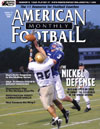AMERICAN FOOTBALL MONTHLY THE #1 RESOURCE FOR FOOTBALL COACHES
Article CategoriesAFM Magazine
|
Nickel Package: Matching Speed with SpeedDesigning a Nickel package to combat the elusiveness of the spread offenseby: Mike Kuchar Senior Writer, American Football Monthly © More from this issue With the continued advancement of spread offenses saturating the game of football, it becomes almost a necessity for defenses to match speed with speed by employing some type of nickel package in their scheme. It seems like not too long ago, coaches were fixated on putting their best eleven defenders in the game, regardless of the type of personnel that they were up against. Rarely was there any two-platoon system where players were subbed on and off the field defensively, like they were offensively. But, now it just seems fair to be able to get your quicker athletes on the field just in order to defend those wide open sets that offenses are producing to score points. Nickel Personnel As most of us know, utilizing the Nickel scheme means bringing one defensive back into the game in replacement for a defensi....The full article can only be seen by subscribers. Subscribe today!
|
|
|||||||
| HOME |
MAGAZINE |
SUBSCRIBE | ONLINE COLUMNISTS | COACHING VIDEOS |
Copyright 2025, AmericanFootballMonthly.com
All Rights Reserved





